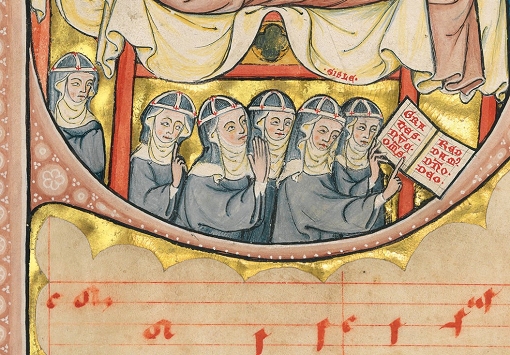The Initial of Puer natus est nobis marks the introit for the third Mass of Christmas Day. It depicts the mystery of Christ’s birth, integrated in a highly suggestive framing: the upper register shows the choir of angels singing Gloria in excelsis Deo, while in the lower section the nuns capella are singing from a chant book (the cantrix is identified as ‘Gis[e]le’).

A closer look at the book reveals what they are meant to sing, viz. the Christmas sequence Grates nunc omnes, which they – if they really used this book – would be actually performing a little later in the course of the celebration. The subtle point of this arrangement is the fact that the angelic speech also serves as the closing words of the sequence: ‘Huic oportet ut canamus cum angelis semper: Gloria in excelsis’ (‘To him we should continuously sing with the angels: Glory in the highest!’). Hence the image suggests a spiritual (= ‘real’ in the domain of faith) unison between the two choirs.
While such elements may indeed be interpreted as records of a specific appropriation of a common canonical heritage. It’s clear that Gisele of Kerssenbrock – who ordered this manuscript to be made, probably even supervised its execution. While singing the liturgical chants, they celebrated together with the angels. Communion while singing.
Just look at the capella again: the schola cantorum in action. The cantrix points to the hymnbook. There it says: Grates nunc omnes reddamus Domino Deo…. “Now let us all give thanks to God the Lord”.

Singing with angels
Again, we are supposed to complete the text and when we do, the title of this post also becomes clear: ‘Singing with the angels’. For that is what the women’s schola in Rulle led by cantrix Gisele did.
Grates nunc omnes reddamus Domino Deo
qui sua nativitate nos liberavit de diabolica potestate.
Huic oportet ut canamus cum angelis
semper sit gloria in excelsis.
Hear, the music starts. I hear the heavenly sounds approaching, not Gregorian but Early-Baroque, the Beschluss of the Historia der Freuden- und Gnadenreichen Geburth Gottes und Marien Sohnes JESU CHRISTI, Heinrich Schütz (1656), a translation of this Christmas sequence (Grates nunc omnes) in German:
Danck sagen wir alle Gott, unsern Herrn Christo.
der uns mit seiner Geburth hat erleuchtet.
Und uns erlöset hat mit seinem Blute von des Teuffels Gewalt.
Den sollen wir alle mit seinen Engeln loben mit Schalle.
Singen: Preiß sey GOTT in der Höhe.
